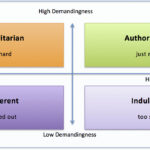If you’re a parent, you know how hard it can be to find the right balance between nurturing and challenging your child. But did you know that the parenting style you choose can have a huge impact on the way your child develops emotionally? In this article, I’ll discuss the link between parenting style and anxious attachment, and how you can use the right parenting techniques to make sure your child feels safe and secure. So if you’re a parent wanting to create a strong and healthy bond with your child, keep reading!
Understanding Anxious Attachment and Its Causes

As a 21-year-old student, I understand that anxious attachment is an important topic and it’s important to understand its causes. From my research, I understand that the parenting style can be a major factor in creating anxious attachment in children. Parents who are not secure and consistent in their parenting, who are inconsistent with their communication and expectations, or who don’t provide emotional support can create an anxious attachment in their children. This can have lasting repercussions on the child’s mental health and well-being and can impact their ability to form healthy relationships later in life.
The Impact of Different Parenting Styles on Anxious Attachment

As a young adult, I’ve come to understand how the parenting styles of my parents have had a lasting impact on me. I’ve been able to recognize that my anxious attachment is largely due to their parenting style. Parents who use authoritarian or inconsistent parenting techniques can cause their children to develop anxious attachment. This type of parenting is characterized by strict rules, hostile reactions, and little emotional support. As a result, children may develop a fear of abandonment and an inability to trust others. I’m thankful that I’ve been able to recognize this and make positive changes in my life.
Benefits of Secure Attachment in Children

Secure attachment in children can have a huge impact on their lives and development. Growing up with a secure attachment can lead to higher self-esteem, better relationships, improved problem-solving skills, and better emotional regulation. Kids with secure attachments have an easier time exploring their environment, are more resilient in difficult situations, and have better communication skills. All of these benefits can last into adulthood, allowing them to more easily navigate relationships and life in general.
Strategies to Foster Secure Attachment in Children

When parenting, it’s important to foster secure attachment in children. Various strategies can be used to do this. First, it’s important to create a safe and secure environment for the child. This means providing the child with reliable and consistent care, as well as providing them with a sense of structure and consistency. Additionally, it’s important to give the child positive attention and affection. This can be done through hugs, spending quality time with them and talking to them about their experiences. Finally, it’s important to be patient and understanding with the child, as this helps to build a trusting relationship. By using these strategies, parents can help to create a secure attachment in their child.
Signs of Anxious Attachment in Children

If you’re worried that your parenting style might be causing an anxious attachment in your child, there are some signs you can look out for. Kids with an anxious attachment may be clingy and constantly seek attention from their parents. They may also be excessively worried and experience difficulty when left alone. They could be overly sensitive to criticism and become easily overwhelmed by stress. Other signs include difficulty sleeping and excessive fear of strangers. It’s important to recognize these behaviors early on and address them in order to help your child develop a healthy attachment.




